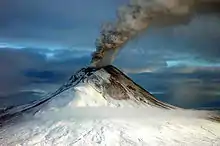National Volcano Early Warning and Monitoring System
The National Volcano Early Warning and Monitoring System is a U.S. federal program within the U.S. Geological Survey for monitoring volcano activity and providing early warning to threatened areas. It was authorized by the John D. Dingell, Jr. Conservation, Management, and Recreation Act on March 12, 2019.
Background

There are 169 young volcanoes in the United States, many of which are considered hazardous due to their proximity to populated areas.[1] The USGS considers many of the more dangerous volcanoes to be under-monitored, lacking adequate scientific instruments on the ground to measure activity and potential threats.[2] Many volcanoes lack any instruments, and the seismometers at other sites are inadequate for useful analysis.[3] One of the most active volcanoes in Washington, Glacier Peak, only has a single seismometer.[4] Improved monitoring capabilities can provide more timely warnings for evacuations and emergency response coordination, and mitigate the impacts of the travel disruptions.[5] Early warnings are particularly critical for air traffic control, which needs to be made aware of ash-producing eruptions in time to reroute airplanes.[6]
The USGS assesses each volcano against a 24-factor hazard and exposure matrix, and assigns a threat level of "very low", "low", "moderate", "high", or "very high".[7] In 2018, 18 volcanoes were rated as "very high" risk, and 39 volcanoes were rated as "high" risk. The "very high" risk volcanoes are in Alaska, Washington, Oregon, California, and Hawaii, with the most dangerous being Kilauea. Some volcano monitoring has been performed by the Volcano Hazards Program, directed by the USGS, but the program lacks sufficient funding to properly close the monitoring gap.[8] According to Charles Mandeville, the program coordinator for the USGS Volcano Hazards Program, the USGS is "somewhere between 30-40 percent of the way to having an ideal monitoring network for those volcanoes”.[9] As of 2018, only three "very high risk" volcanoes are categorized as "well monitored": Kilauea, Mount St. Helens, and Long Valley Caldera.[10]
Purpose
The National Volcano Early Warning and Monitoring System has two purposes:[11]
- To "organize, modernize, standardize, and stabilize the monitoring systems of the volcano observatories in the United States, which includes the Alaska Volcano Observatory, California Volcano Observatory, Cascades Volcano Observatory, Hawaiian Volcano Observatory, and Yellowstone Volcano Observatory".
- To "unify the monitoring systems of volcano observatories in the United States into a single interoperative system".
Details
The USGS must submit a five-year plan for monitoring all U.S. volcanoes at a level commensurate with the threat posed by each.[11] The plan will include upgrades to existing networks on monitored volcanoes and installing networks on unmonitored volcanoes, as well as standardizing on modern tools across all of the volcano observatories. A national volcano data center will coordinate activities among the observatories.[2] A watch office will be operational 24 hours a day, 7 days a week.[11] In addition, the USGS will set up a grants program to support research into techniques for monitoring and analyzing volcanic activity.[9]
The National Volcano Early Warning and Monitoring System was authorized $55,000,000 for fiscal years 2019 through 2023, however the funds still need to be appropriated.[9]
References
- "National Volcano Early Warning System - monitoring volcanoes according to their threat". USGS. Retrieved 21 March 2019.
- McClatchy, Julianna Rennie. "More than one-third of US volcanoes are under-monitored. Congress is noticing". The Daily News. Retrieved 21 March 2019.
- LaFrance, Adrienne. "The Scary State of Volcano Monitoring in the United States". The Atlantic. Retrieved 21 March 2019.
- Klemetti, Eric. "The US Needs to Seriously Beef Up Its Volcano Monitoring". Wired. Retrieved 21 March 2019.
- Ross, Erin. "Scientists Getting New Tools To Monitor The Northwest's Volcanoes". Oregon Public Broadcasting. Retrieved 22 March 2019.
- "USGS Creates Framework For National Volcano Early Warning System". Science Daily. Retrieved 21 March 2019.
- Ewert, John W.; Diefenbach, Angela K; Ramsey, David W. "2018 update to the U.S. Geological Survey national volcanic threat assessment". U.S. Geological Survey. Retrieved 21 March 2019.
- "National Volcano Early Warning and Monitoring System Legislation in the 116th Congress". Congressional Research Service Reports. Retrieved 21 March 2019.
- Andrews, Robin George. "The U.S. May Finally Get an Early Warning System For Volcanoes". Gizmodo: Earther. Retrieved 21 March 2019.
- Lewis, Forrest. "National Volcano Warning System Gains Steam". Earth & Space Science News. Retrieved 24 April 2019.
- "John D. Dingell, Jr. Conservation, Management, and Recreation Act" (PDF). Congress.gov. Retrieved 21 March 2019.
Further reading
- Observing the Volcano World: Volcano Crisis Communication
- An assessment of volcanic threat and monitoring capabilities in the United States: framework for a National Volcano Early Warning System
- Instrumentation Recommendations for Volcano Monitoring at U.S. Volcanoes Under the National Volcano Early Warning System